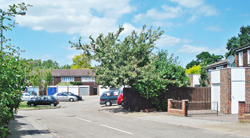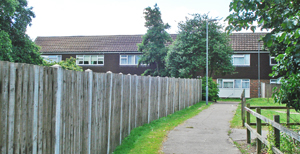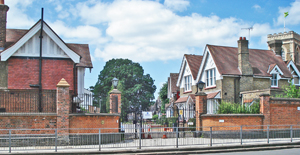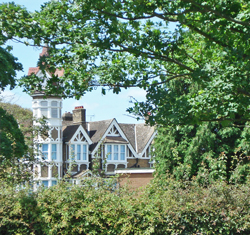Australasian Hospital
and Medical Unit
and Medical Unit
Tanners Lane, Barkingside, Ilford, Essex IG6 1QG
Medical
dates:
Medical
character:
Acute
The Girl's Village Home (see below) was built in 1875 by Dr Thomas Barnardo
(1845-1905) as a home for destitute girls. The Village had a
sanatorium for tubercular children, which had opened in 1904, but Dr
Barnardo also wished to establish a hospital and medical
facility. He died in 1905 before he could achieve this.
In 1908, in order to raise £22,000 for a hospital, Revd W.J. Mayers, the Deputation Secretary for Dr Barnardo's Homes, began a lengthy tour through Australia and New Zealand. For part of the time he was accompanied by ten Barnardo boys, who performed musical pieces on instruments which included hand-bells, sleigh bells, xylophones, dulcimers, ocarinas, mandolins and bagpipes. The tour lasted two years and two months, during which time Revd Mayers had delivered over 300 sermons and conducted 433 meetings - raising £17,500 in donations towards the hospital. In Australia, a member of the federal Parliament, James Page, himself an ex-Barnardo boy, started a subscription list among his fellow members, having provided a generous donation himself.
On 22nd June 1910 Sir George Reid, High Commissioner for Australia, laid the foundation stone for the new hospital, to be built just to the southeast of the Edmund Hannay Watts Sanatorium. Because the full sum had not been raised, the design for the hospital had had to be modified.
The Australasian Hospital opened on 6th May 1911. It had 66 beds and had cost £18,000 to build (without furnishings). It comprised three parallel ward blocks, linked to a central administrative block by a corridor. The central block contained the Out-Patients Department, the X-ray room, the operating theatre and other healthcare facilities. Modern and well-equipped, the Hospital treated children from all the other Barnardo Homes and foster homes, including those with acute tuberculosis (less severe and convalescent TB patients were treated in the adjacent Sanatorium).
At the outbreak of WW2 in 1939 the children were evacuated and the cottages were used as emergency housing for people who had lost their homes during the Blitz. The Hospital became a convalescent hospital for patients from the London Hospital. During the war some 16 bombs landed on the Village site.
At the end of the war in 1945 the children returned, although some of the displaced families from London remained.
In 1947 the Hospital merged with the John Capel Hanbury Hospital in the Boys' Garden City, Woodford Bridge.
In 1959 the Hospital had 60 beds. One of the wards had been divided and another fitted with separate cubicles. On 30th June 1959 it contained 42 in-patients; there were 36 resident members of staff.
Although the Hospital had not joined the NHS in 1948, arrangements were made for consultant physicians and ophthalmic and ENT surgeons to hold clinics and to carry out operations. It became an affiliated training school to the King Edward Memorial Hospital in Ealing.
By the beginning of the 1960s, with the introduction of family rehabilitation units, the nature of the work in the Hospital began to change - the number of acute patients decreased, while the number of physically and mentally handicapped children needing care increased.
The Hospital closed in the late 1960s and the land was sold for housing.
The name 'Australasian Medical Unit' was transferred to two cottages - Ivy and Oxford - in the Village Home. These had been specially adapted for the care of 16 severely handicapped babies and toddlers. These in turn closed in July 1975 and the children were transferred to the newly built New Mossford.
In 1908, in order to raise £22,000 for a hospital, Revd W.J. Mayers, the Deputation Secretary for Dr Barnardo's Homes, began a lengthy tour through Australia and New Zealand. For part of the time he was accompanied by ten Barnardo boys, who performed musical pieces on instruments which included hand-bells, sleigh bells, xylophones, dulcimers, ocarinas, mandolins and bagpipes. The tour lasted two years and two months, during which time Revd Mayers had delivered over 300 sermons and conducted 433 meetings - raising £17,500 in donations towards the hospital. In Australia, a member of the federal Parliament, James Page, himself an ex-Barnardo boy, started a subscription list among his fellow members, having provided a generous donation himself.
On 22nd June 1910 Sir George Reid, High Commissioner for Australia, laid the foundation stone for the new hospital, to be built just to the southeast of the Edmund Hannay Watts Sanatorium. Because the full sum had not been raised, the design for the hospital had had to be modified.
The Australasian Hospital opened on 6th May 1911. It had 66 beds and had cost £18,000 to build (without furnishings). It comprised three parallel ward blocks, linked to a central administrative block by a corridor. The central block contained the Out-Patients Department, the X-ray room, the operating theatre and other healthcare facilities. Modern and well-equipped, the Hospital treated children from all the other Barnardo Homes and foster homes, including those with acute tuberculosis (less severe and convalescent TB patients were treated in the adjacent Sanatorium).
At the outbreak of WW2 in 1939 the children were evacuated and the cottages were used as emergency housing for people who had lost their homes during the Blitz. The Hospital became a convalescent hospital for patients from the London Hospital. During the war some 16 bombs landed on the Village site.
At the end of the war in 1945 the children returned, although some of the displaced families from London remained.
In 1947 the Hospital merged with the John Capel Hanbury Hospital in the Boys' Garden City, Woodford Bridge.
In 1959 the Hospital had 60 beds. One of the wards had been divided and another fitted with separate cubicles. On 30th June 1959 it contained 42 in-patients; there were 36 resident members of staff.
Although the Hospital had not joined the NHS in 1948, arrangements were made for consultant physicians and ophthalmic and ENT surgeons to hold clinics and to carry out operations. It became an affiliated training school to the King Edward Memorial Hospital in Ealing.
By the beginning of the 1960s, with the introduction of family rehabilitation units, the nature of the work in the Hospital began to change - the number of acute patients decreased, while the number of physically and mentally handicapped children needing care increased.
The Hospital closed in the late 1960s and the land was sold for housing.
The name 'Australasian Medical Unit' was transferred to two cottages - Ivy and Oxford - in the Village Home. These had been specially adapted for the care of 16 severely handicapped babies and toddlers. These in turn closed in July 1975 and the children were transferred to the newly built New Mossford.
Present status (June 2008)
The site of the Hospital is now occupied by Asthall Gardens, part of the low-rise terraced housing built over much of the Village site.
Less than half the original greens of the Village Home survive, but many of the Scots pines and oaks are still in evidence. By 1997 the three Victorian fountains had been restored. In 1999 the Camelia Botnar Foundation installed replica railings, iron gates and lanterns by the main entrance.
In 2000 some 11 cottages were leased to the Anchor Housing Association. They were converted into apartments for retired people.
In all, 22 of the cottages have survived; many are in use as offices and staff accommodation.


Asthall Gardens now occupies the site of the Hospital.

Ashurst Drive by Asthall Gardens.

Looking south towards Asthall Gardens.

The newly restored gated entrance on Horns Road. The Porter's Lodge is shown on the left and original cottages on the right.

Cairns House, built in 1887 in memory of Earl Cairns, first President of Dr Barnardo's charity, has been restored. It was Grade II listed in 2010.

Tesco's supermarket is at the southwest corner of the site.
The
Village Home for Girls was founded by Dr Thomas John Barnardo
(1845-1905) in 1875. The first cottages were built on a 13-acre
site located between Cranbrook Road and Horns Road, near the Mossford
Lodge estate where the Barnardos had begun their married life.
The 13 cottages, built parallel to Horns Road at the east of the site, were officially opened on 9th July 1876 by Lord Cairns. Each was named after a flower or plant - Woodbine, Daisy, Honeysuckle, Primrose, etc - and housed 16 girls, who were presided over by a 'mother'.
By 1880 some 26 cottages had been added, paid for by various organisations and individual donors. They occupied three sides of a large open green.
On 6th August 1887 the Cairns Memorial Cottage (later renamed Cairns House) was opened as the administrative building for the Village.
More land was acquired and, from 1887 to 1889 another group of cottages was added around a smaller green (known as Babies Green), west of the Horns Road entrance. The new buildings each housed 25 children.
In 1892 the Children's Church was built in the Gothic style. The size of the pews were scaled down to accommodate the junior congregation.
A school was added to the site in 1896, and another in 1901.
A commodious block with 67 beds was erected in memory of Queen Victoria as a Receiving House for new arrivals. It was opened on 11th July 1903 by the Duke of Argyll.
In July 1904 the Edmund Hannay Watts Sanatorium opened, funded by Fenwick Shadforth Watts in memory of his father. (The Watts, of the shipping firm Watts, Watts & Co., had founded the Watts Naval Training School for Barnardo's boys in 1903.) The Sanatorium was based on the open-air plan and treated girls with tuberculosis.
During the years 1903 to 1906 more cottages were built around another large green to the west of the original buildings. To enable access to this section of the site, three of the original cottages - Beehive, Eton and Hahnemann - were demolished. Two of the new cottages were named Beehive and Eton. The new buildings each accommodated 20 girls.
By 1908 the 'model village' occupied 60 acres and housed around 1,500 girls and a few small boys. It consisted of 62 detached cottages for girls of different ages, as well as 11 other buildings, including schoolrooms, workshops, a church and a laundry (which washed 18,500 items a week).
As well as attending school, where they were taught domestic skills - cooking, dressmaking and art needlework - to enable them to find work when they were old enough, the children also undertook gardening duties.
Dr Barnardo had hoped to add a hospital with full medical facilities to the site, but he died of heart failure on 19th September, 1905, before he could realize this ambition. He was cremated and his ashes buried in the grounds of the Village (his memorial still exists there).
A hospital (see above) finally opened in 1911, after a fund-raising tour of the Antipodes.
During the 1930s boys began to be admitted to the Village Home.
In 1939, at the outbreak of WW2, the children were evacuated and the cottages were used to temporarily accommodate those who had lost their homes due to air-raids.
At the end of the war in 1945 the children returned, but only about a third of the cottages were available for them; the majority still housed homeless families from London.
By 1964 some 600 children were accommodated in 60 cottages, but government policy began to favour smaller family groups and gradually the number of children in the Village was reduced to about 100.
In 1967 a new headquarters was built for the Barnardo's charity on the site of the orchard. It opened in 1969 and, in the same year, 30 acres of land was sold to the London Borough of Redbridge (it was later resold to a supermarket chain).
In 1975 New Mossford, a residential school for young disabled people, opened in the Villlage. Residents in the Australasian Hospital and the Hanbury Hospital Home were transferred to the new building.
By 1986 the Village had only 44 children in residence. The site was deemed too isolated from the local community and too old-fashioned in terms of modern child welfare. It ceased to be a children's home in 1991.
The 13 cottages, built parallel to Horns Road at the east of the site, were officially opened on 9th July 1876 by Lord Cairns. Each was named after a flower or plant - Woodbine, Daisy, Honeysuckle, Primrose, etc - and housed 16 girls, who were presided over by a 'mother'.
By 1880 some 26 cottages had been added, paid for by various organisations and individual donors. They occupied three sides of a large open green.
On 6th August 1887 the Cairns Memorial Cottage (later renamed Cairns House) was opened as the administrative building for the Village.
More land was acquired and, from 1887 to 1889 another group of cottages was added around a smaller green (known as Babies Green), west of the Horns Road entrance. The new buildings each housed 25 children.
In 1892 the Children's Church was built in the Gothic style. The size of the pews were scaled down to accommodate the junior congregation.
A school was added to the site in 1896, and another in 1901.
A commodious block with 67 beds was erected in memory of Queen Victoria as a Receiving House for new arrivals. It was opened on 11th July 1903 by the Duke of Argyll.
In July 1904 the Edmund Hannay Watts Sanatorium opened, funded by Fenwick Shadforth Watts in memory of his father. (The Watts, of the shipping firm Watts, Watts & Co., had founded the Watts Naval Training School for Barnardo's boys in 1903.) The Sanatorium was based on the open-air plan and treated girls with tuberculosis.
During the years 1903 to 1906 more cottages were built around another large green to the west of the original buildings. To enable access to this section of the site, three of the original cottages - Beehive, Eton and Hahnemann - were demolished. Two of the new cottages were named Beehive and Eton. The new buildings each accommodated 20 girls.
By 1908 the 'model village' occupied 60 acres and housed around 1,500 girls and a few small boys. It consisted of 62 detached cottages for girls of different ages, as well as 11 other buildings, including schoolrooms, workshops, a church and a laundry (which washed 18,500 items a week).
As well as attending school, where they were taught domestic skills - cooking, dressmaking and art needlework - to enable them to find work when they were old enough, the children also undertook gardening duties.
Dr Barnardo had hoped to add a hospital with full medical facilities to the site, but he died of heart failure on 19th September, 1905, before he could realize this ambition. He was cremated and his ashes buried in the grounds of the Village (his memorial still exists there).
A hospital (see above) finally opened in 1911, after a fund-raising tour of the Antipodes.
During the 1930s boys began to be admitted to the Village Home.
In 1939, at the outbreak of WW2, the children were evacuated and the cottages were used to temporarily accommodate those who had lost their homes due to air-raids.
At the end of the war in 1945 the children returned, but only about a third of the cottages were available for them; the majority still housed homeless families from London.
By 1964 some 600 children were accommodated in 60 cottages, but government policy began to favour smaller family groups and gradually the number of children in the Village was reduced to about 100.
In 1967 a new headquarters was built for the Barnardo's charity on the site of the orchard. It opened in 1969 and, in the same year, 30 acres of land was sold to the London Borough of Redbridge (it was later resold to a supermarket chain).
In 1975 New Mossford, a residential school for young disabled people, opened in the Villlage. Residents in the Australasian Hospital and the Hanbury Hospital Home were transferred to the new building.
By 1986 the Village had only 44 children in residence. The site was deemed too isolated from the local community and too old-fashioned in terms of modern child welfare. It ceased to be a children's home in 1991.
(Author unstated) 1908 Dr Barnardo's Homes. The new hospital for the Girls' Village. West Australian, 10th June, 2.
(Author unstated) 1909 For God and humanity. Dr Barnardo's Homes. Otago Daily Times, 12th March, 6.
(Author unstated) 1909 Dr Barnardo's Homes. Wanganui Chronicle, 19th June, 5.
(Author unstated) 1910 The new Australasian hospital. Evelyn Observer and Bourke East Record, 2nd December, 4.
http://canadianbritishhomechildren.weebly.com
http://trove.nla.gov.au
http://wellcomelibrary.org
www.barnardos.org.uk (1)
www.barnardos.org.uk (2)
www.barnardos.org.uk (3)
www.britishhomechildgroupinternational.com
www.british-history.ac.uk
www.childrenscottagehomes.org.uk
www.childrenshomes.org (1)
www.childrenshomes.org (2)
www.goldonian.org (1)
www.goldonian.org (2)
www.goldonian.org (3)
www.goldonian.org (4)
www.londongardensoline.org.uk
www.newspapers.com
Return to home page